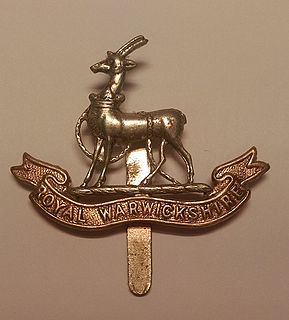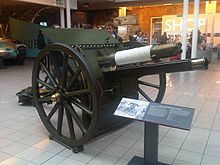
The 60th Division was an infantry division of the British Army raised during the First World War. It was the second line-formation of the 47th Division, and was the second of two such Territorial Force divisions formed from the surplus of London recruits in 1914.

266 Battery Royal Artillery is a Royal Artillery unit of the British Army Reserve. It was first formed in Bristol in 1859 and served through World War I as field artillery and World War II as anti-aircraft (AA) artillery.
The Birmingham Rifles was a volunteer unit of the British Army founded in Birmingham in 1859. As the 5th Battalion, Royal Warwickshire Regiment, it served as infantry on the Western Front and in Italy during World War I. Its successor units served in air defence during the early part of World War II, and later as anti-tank gunners in the Burma Campaign.
The 2nd Kent Artillery Volunteers, later 4th London Brigade, Royal Field Artillery, popularly known as the Lewisham Gunners, was a volunteer unit of the British Army from 1860 until 1967. Initially raised in suburban West Kent, its recruiting area was later incorporated within the County of London. It provided two active service units in each of the World Wars, operating as far afield as Sicily, Burma and Madagascar, and later provided an airborne unit in the Territorial Army of the 1950s.
The 1st Suffolk Artillery Volunteers was a unit of Britain's Volunteer Force and Territorial Army from 1860 until 1955. Raised at Lowestoft in Suffolk, it served under various designations, as field artillery in Palestine during World War I and as heavy anti-aircraft artillery defending the UK during World War II.

The 3rd North Midland Brigade, Royal Field Artillery was a volunteer unit of the British Territorial Force formed in 1908. It served in some of the bloodiest battles on the Western Front during World War I
The 1st Cinque Ports Artillery Volunteers was a part-time unit of the British Army's Royal Artillery from 1860 to 1956. Raised as coastal defence artillery, the unit later served as field artillery in Mesopotamia during World War I, and as anti-aircraft artillery during the Blitz and in the Middle East during World War II.

The 6th Battalion, Royal Warwickshire Regiment was a unit of Britain's Territorial Army (TA) from 1908 until 1961. Recruited from Birmingham, it served as infantry in some of the bloodiest fighting on the Western Front and in Italy during World War I. Converted to an Anti-Aircraft (AA) role, it defended the West Midlands during The Blitz in the early part of World War II, and then joined Eighth Army in North Africa, including service in the famous Siege of Tobruk and in the Italian Campaign. It served on in the air defence role in the postwar TA until 1961.

The 4th North Midland Brigade, sometimes known as the 'Derbyshire Howitzers', was a part-time unit of Britain's Royal Field Artillery created in 1908 as part of the Territorial Force. It served on the Western Front in World War I. Reorganised between the wars, it was later converted to the anti-aircraft (AA) role. During World War II, part of the regiment served in the Siege of Malta but the rest was captured at the Fall of Tobruk. The reconstituted regiment served on in Anti-Aircraft Command until 1955 and as a unit of the Royal Engineers until 1967.

The IV (4th) Lowland (Howitzer) Brigade, Royal Field Artillery was a new unit formed when Britain's Territorial Force was created in 1908. Its origins lay in the 1st Lanarkshire Artillery Volunteers formed in Glasgow, Scotland, in the 1860s. During World War I the brigade served at Gallipoli and in Egypt. It was broken up in 1916, but its individual batteries served on with other Scottish artillery units for the rest of the war and into World War II.

The 8th London (Howitzer) Brigade, Royal Field Artillery was a new unit formed when Britain's Territorial Force was created in 1908. Its origin lay in Artillery Volunteer Corps formed in the 1860s in Plumstead, Kent, later incorporated into London. Together with its wartime duplicate the brigade served during the First World War on the Western Front, at Salonika and in Palestine where it was the first British unit to enter Jerusalem. It again formed two units for service in the Second World War, one of which saw extensive action in France, North Africa, and Italy, while its duplicate was captured at the Fall of Singapore. Its successor unit continues in the Army Reserve today.

The 33rd Divisional Artillery, popularly known as the Camberwell Gun Brigade, was a Royal Artillery force raised as part of 'Kitchener's Army' in early 1915. Recruited in the Borough of Camberwell, South London, the units served with the 'Pals battalions' of the 33rd Division on the Western Front for three years. They also supported other formations when 33rd Division was out of the line. The batteries saw action at the Somme, Arras, and Ypres, suffering heavy casualties. They were particularly distinguished defending against the German spring offensive of 1918, and continued through the victorious Allied Hundred Days Offensive.

The 39th (Deptford) Divisional Artillery was a Royal Artillery force raised as part of 'Kitchener's Army' in early 1915. Recruited in Deptford, South London, the units served with the 'Pals battalions' of the 39th Division on the Western Front for two years. They saw action at the Somme, Ypres, and the German spring offensive, including the Battle of the Avre, described as 'one of the finest artillery stories of the whole war'. The units then operated as an independent artillery formation during the Allied Hundred Days Offensive.

The 32nd Divisional Artillery was a Royal Artillery force raised as part of 'Kitchener's Army' in early 1915. Recruited in Yorkshire, originally for the 31st Division, the units served with the 'Pals battalions' of the 32nd Division on the Western Front for three years. They saw action at the Somme, the pursuit to the Hindenburg Line, the German spring offensive, and the Allied Hundred Days Offensive.

The 155th Brigade, Royal Field Artillery, was a New Army unit raised from Leeds in the West Riding of Yorkshire during World War I. It saw service on the Western Front, including the Battles of the Somme, Arras, Messines and Passchendaele, the German spring offensive and the final Allied Hundred Days Offensive.

The Manchester Artillery is a Volunteer unit of the British Army first raised in the City of Manchester in 1860, whose successors continue to serve in the Army Reserve today. It became a brigade of the Royal Field Artillery in the Territorial Force in 1908, and in World War I it served in Egypt in 1915–17 before being broken up. Its second line unit went to the Western Front in 1917, seeing action at Ypres, against the German Spring Offensive, and leading the pursuit in the Allies' victorious Hundred Days Offensive. Just before World War II the Manchester Artillery again formed a duplicate. While the parent regiment served in the Battle of France including the Dunkirk evacuation, and later in the Middle East and the Italian campaign, its duplicate fought in Normandy and North West Europe. Both regiments were reformed postwar, but after a number of amalgamations they and several other Manchester-based units were reduced into 209 Battery in the present-day Army Reserve.

The Bolton Artillery, under various titles, has been a Volunteer unit of the British Army based in Bolton, Lancashire, since 1889. In World War I it served in Egypt and Gallipoli in 1915–17, and then on the Western Front for the rest of the war, including Passchendaele, the German Spring Offensive and the Allied Hundred Days Offensive. Just before the outbreak of World War II the regiment formed a duplicate unit. The parent regiment served in the Battle of France and was evacuated from Dunkirk. Both regiments served at the Battle of Alamein and in the Italian Campaign, while one of the regiments was involved in the intervention in Yugoslavia. The regiment was reformed postwar, and after a number of mergers its successors continue to serve in today's Army Reserve.
The 1st Worcestershire Artillery Volunteers was a part-time unit of Britain's Royal Artillery dating back to 1865. As part of the Territorial Force it served on the Western Front and in Italy during World War I. In World War II it served in the Battle of France and was evacuated from Dunkirk. It later fought in Tunisia and Italy. After a series of postwar mergers, it continues as a battery in today's British Army Reserve.
The 2nd (Leeds) Yorkshire Engineer Volunteers was a part-time unit of the British Army raised in 1861. When the Territorial Force was formed in 1908 the corps was converted into signals and artillery units, in which roles they served through World War I. Postwar they were absorbed into other West Yorkshire units.

The 1st Warwickshire Volunteer Artillery, or 'Balsall Heath Artillery', was a part-time unit of Britain's Royal Artillery recruited from Birmingham. It served on the Western Front during World War I, including the Battles of the Somme, Vimy Ridge, Messines, Ypres, the German Spring Offensive and the final victorious Hundred Days Offensive. During World War II it fought in the Battle of France and was evacuated from Dunkirk. Later in served in the Italian Campaign. It continued in the postwar Territorial Army, through a series of mergers, until 1971.









